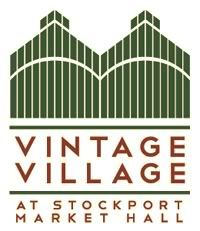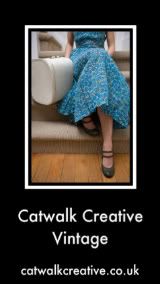Our family wasn't that well off when I was growing up, so we bought and used a lot of what was then called 'second hand' stuff. We lived on RAF camps, which had 'thrift shops' (a curiously trans-Atlantic term which might have been unique to the armed forces, or even just the RAF, I'm not sure).
So I was accustomed to browsing round these thrift shops, second-hand stores and dusty house clearance businesses - I can't remember there being that many charity shops in the 1970s - with my mother from an early age.
I remember distinctly my first 'vintage' dress purchase. It was from a shop in Ipswich, Suffolk, the nearest big town to our RAF camp of the time, and it cost me 50p. I was probably about eight or nine.
Midnight blue silk satin, high neck gathered with two rows of cord elastic forming a little ruffle around the neck, long loosely cut sleeves similarly gathered at the wrist and alternating panels of the satin and its 'wrong' matt side making up the flared skirt, which was approximately knee length (if you were of adult height).
It was a beautiful dress and I had it a long time, although I don't remember ever wearing it but just enjoying it for its luxurious satin cloth and impossibly neat construction.
Much later on I identified it as a 1930s evening dress, but its short length was completely inappropriate for the time. Evening gowns in the 30s were always full length. Eventually I realised that it must have been shortened during the Second World War to conform to contemporary fashion, possibly for use as a dance dress, in the days when people were forced to raid their wardrobes for older clothes and adapt them because they couldn't afford the ration coupons to buy new gear. You couldn't possibly do the jitterbug in a floor length gown!
Some might think it had been ruined by having its skirt brutally chopped off and its careful proportions ruined, but this clear evidence of customisation made it all the more interesting to me, rather than less. This dress told a story, and was the start of my fascination with material culture, although I didn't know that term at the time. That is, how people use and adapt products and their attitudes and feelings about them, rather than focusing on the producer/designer. Consumption as a focus, rather than production.
Most popular history books about fashion and design are completely directed towards the designer and his or her career and notable achievements. Whilst material culture is well established as a field of research in academia, it has yet to make that leap to popular publishing because most readers prefer the hagiographies of elite designers that have set the template for conventional fashion/design histories.
Some museums even to this day would not be interested in a garment that had been substantially altered and would prefer something that was as near to new as possible (in other words, in the form that it was originally intended to be), disregarding the life and history, and changes, that its users/wearers might have needed to impose on it in order to continue wearing it. So in most cases, they are only interested in items that bear no trace of use and aren't interested in the consumer, only the producer. The consumer is effectively erased and ignored. But for me, that's when it starts to get interesting.
I wish I still had that dress!
Saturday, 31 October 2009
Subscribe to:
Post Comments (Atom)






No comments:
Post a Comment